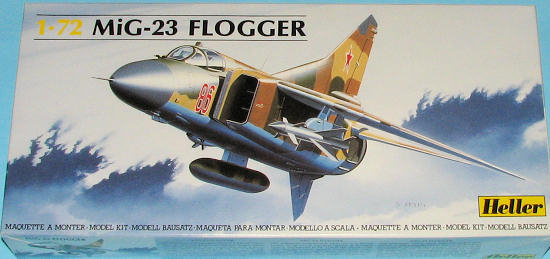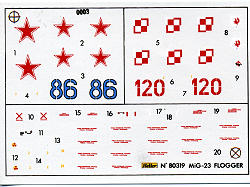
Heller 1/72 MiG-23 'Flogger'
| KIT: | Heller 1/72 MiG-23 'Flogger' |
| KIT #: | 80319 |
| PRICE: | $ |
| DECALS: | Two Options |
| REVIEWER: | Scott Van Aken |
| NOTES: | I believe this is an Airfix mold |

| HISTORY |
The Mikoyan-Gurevich MiG-23 (Russian: Микоян и Гуревич МиГ-23; NATO reporting name: "Flogger") is a swing-wing fighter aircraft, designed by the Mikoyan-Gurevich bureau in the Soviet Union and is considered to belong to the "Third Generation" aircraft category along with similar aged Russian-produced fighters like the MiG-25 "Foxbat". It was the first Soviet fighter with a look-down/shoot-down radar and beyond visual range missiles, and the first MiG production fighter plane to have intakes at the sides of the fuselage. Production started in 1970 and reached large numbers with over 5,000 aircraft built. Today the MiG-23 remains in limited service with various export customers.
As the Flogger A (MiG-23S/MS) was not that widely built or sold and had several major deficiencies in equipment, it is most likely that this kit is a Flogger B. Information on those versions is listed below.
| THE KIT |
 Not what one would consider a cutting edge design in today's market. But when it first appeared in the mid/late 1970s, it was very much the norm with raised panel lines and fairly good detailing for the time. One must remember that during these heady days, it was not uncommon for a model company to provide a new-mold kit release or two every month. Of course, in today's economy that is not always possible, but things have changed; and from my perspective, most of it is for the better.
Not what one would consider a cutting edge design in today's market. But when it first appeared in the mid/late 1970s, it was very much the norm with raised panel lines and fairly good detailing for the time. One must remember that during these heady days, it was not uncommon for a model company to provide a new-mold kit release or two every month. Of course, in today's economy that is not always possible, but things have changed; and from my perspective, most of it is for the better.
The fuselage is split into upper and lower halves as befits a model of an aircraft with variable geometry wings. A Spartan cockpit consisting of little more than floor, seat, control stick, pilot (to help fill the space) and instrument panel are supplied. This isn't a major problem as the one piece canopy is a bit thick. There is more than enough room in the nose for the required weight. The swing wings are connected by a simple bar and if one doesn't play with it too much, it should be sufficient. The tail section is an unusual construct as the upper rear fuselage is incorporated with each fin half. A connector bar is provided for the horizontal stabilizers, which need to be installed when the fin halves are cemented together. This makes them prime targets for breaking off when one fills the inevitable seam between the upper and lower rear fuselage.
 Landing gear are fairly well done and sturdy. The main wheels have a notch in them for the mud guards while those for the nose are molded in place. Lower fin is designed to be molded in the folded position as would be the norm while on ground. For things under wings, one has a centerline fuel tank and the option of various missiles on the wing glove and under fuselage. These have some sink marks on the pylons and ejector marks on the missile bodies. A centerline gun is also provided.
Landing gear are fairly well done and sturdy. The main wheels have a notch in them for the mud guards while those for the nose are molded in place. Lower fin is designed to be molded in the folded position as would be the norm while on ground. For things under wings, one has a centerline fuel tank and the option of various missiles on the wing glove and under fuselage. These have some sink marks on the pylons and ejector marks on the missile bodies. A centerline gun is also provided.
Instructions are well done with Humbrol paint references. Decals are nicely printed and are matte with relatively large clear surrounds. They are for two aircraft, both of them in the multi-colored camouflage as shown on the box art. No unit information is provided, but one is for a Soviet and the other a Polish aircraft. The markings guide shows insignia on the upper wing of the Polish aircraft which may not be prototypical so some research may be needed.
| CONCLUSIONS |
I'll be the first to admit that Soviet aircraft are not something that I see a lot of on contest tables. It seems that their jets are not hugely popular in the US as kits of them can often be found deeply discounted on vendor tables. This is good news for a modeler on a budget as the kits are not that bad and can easily be made into very nice representations. That would include this one. If you see one at your next show, plunk down a few dollars/euros/quatloos and pick it up.
| REFERENCES |
Thanks to the kind donation of friends for this one.
May 2008 If you would like your product reviewed fairly and fairly quickly, please contact the editor or see other details in the